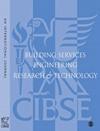The primary energy factor and carbon intensity of waste energy
IF 1.8
4区 工程技术
Q3 CONSTRUCTION & BUILDING TECHNOLOGY
Building Services Engineering Research & Technology
Pub Date : 2022-11-22
DOI:10.1177/01436244221138778
引用次数: 0
Abstract
The energy performance of appliances, buildings and groups of buildings is commonly assessed in terms of equivalent carbon emissions or primary energy, usually following procedures defined by regulations. The most appropriate treatment of energy (usually heat) that is rejected as waste from one process, but which may be a useful input to another process, is not obvious and has proved to be problematic. This note describes and illustrates how the situation can be handled by adapting a procedure that is already in use for somewhat similar purposes. The direct users of the approach are likely to be developers and system designers, but since the procedures are often set by regulation, the most important potential users are those responsible for the regulations The principal features of the procedure are that • The use of waste energy reduces the primary energy (or carbon emissions) attributed to the “donor” process: by allocating some of it to the eventual user: an equitable principle. • The total primary energy (or carbon emissions) of the output streams equals the input to the transformation process: a fundamental requirement • The PEF values of outputs are never negative: required for physical plausibility • If there is only one useful output, all the primary energy is assigned to it: for consistency with the fundamental assumptions of the policy metric • The PEF assigned to the recipient user is lower than that of the alternative supply (if its PEF is zero, so is the that of the waste heat) The principal challenge is the need to define a “counterfactual” alternative source of energy for the recipient’s energy needs: options for this this discussed in the note Practical application : The question of the most appropriate convention for the assignment of primary energy and carbon emissions to the application of energy flows that have traditionally considered to be waste has gained importance in recent years, especially in the context of energy distribution systems that transfer energy between buildings. It seems reasonable that the “donor” of the waste energy should be incentivised by a reduction of the primary energy consumption or carbon emissions that is attributed to them (with the reduction balanced by a compensating attribution to the user of the “waste” energy). This is not reflected by the currently widespread convention that waste energy can always be considered to have a carbon intensity and primary energy factor (PEF) of zero. This Technical Note sets out a procedure to achieve this. It is suggested that its application would result in a more equitable and consistent attribution of primary energy and carbon emissions and therefore more robust design of systems that reuse “waste” energy.废弃能源的一次能源因子和碳强度
电器、建筑物和建筑群的能源性能通常根据当量碳排放或一次能源进行评估,通常遵循法规规定的程序。能量(通常是热)作为废物从一个过程中被丢弃,但它可能是另一个过程的有用输入,最适当的处理方法是不明显的,并且已被证明是有问题的。本文描述并说明了如何通过调整已经用于类似目的的过程来处理这种情况。该方法的直接用户可能是开发人员和系统设计师,但由于程序通常由法规设定,最重要的潜在用户是那些负责法规的人。该程序的主要特点是:•废物能源的使用减少了归因于“捐助者”过程的初级能源(或碳排放):通过将其中一些分配给最终用户:公平原则。•输出流的总一次能源(或碳排放)等于转换过程的输入:一个基本要求•输出的PEF值永远不会为负:需要物理合理性•如果只有一个有用的输出,所有的一次能源都分配给它:•分配给接收用户的PEF低于替代供应的PEF(如果其PEF为零,则废热的PEF为零)主要挑战是需要为接收方的能源需求定义一个“反事实”的替代能源:在说明中讨论的此选项实际应用:关于将初级能源和碳排放分配给传统上被认为是废物的能源流的应用的最适当公约的问题近年来变得越来越重要,特别是在建筑物之间转移能源的能源分配系统方面。似乎合理的是,废物能源的“捐助者”应该通过减少归因于他们的初级能源消耗或碳排放来激励(通过补偿归因于“废物”能源的用户来平衡减少)。目前普遍认为废物能源的碳强度和一次能源因子(PEF)为零的惯例并没有反映出这一点。本技术说明列出了实现这一目标的程序。有人建议,它的应用将导致一次能源和碳排放的归属更公平和一致,因此更有力地设计再利用“废物”能源的系统。
本文章由计算机程序翻译,如有差异,请以英文原文为准。
求助全文
约1分钟内获得全文
求助全文
来源期刊

Building Services Engineering Research & Technology
工程技术-结构与建筑技术
CiteScore
4.30
自引率
5.90%
发文量
38
审稿时长
>12 weeks
期刊介绍:
Building Services Engineering Research & Technology is one of the foremost, international peer reviewed journals that publishes the highest quality original research relevant to today’s Built Environment. Published in conjunction with CIBSE, this impressive journal reports on the latest research providing you with an invaluable guide to recent developments in the field.
 求助内容:
求助内容: 应助结果提醒方式:
应助结果提醒方式:


